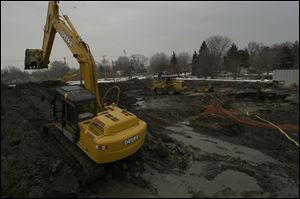
City stuck with cleanup tab at E. Toledo oil leak
3/13/2003
The city cleanup at the former Oakdale Greenhouse will take at least a week more.
Toledo is spending thousands of dollars to clean up an oil spill on the city's east side that came from old underground storage tanks that cracked because freeze-thaw cycles.
Crews have been at the former Oakdale Greenhouse, 1415 Holmes St., since a resident complained of oil-soaked snow March 5.
Tons of contaminated soil are being excavated from a 200-by-400-foot swath of land, officials said.
About 4,000 to 5,000 gallons of liquid have been recovered. Of that amount, probably no more than 1,000 gallons of it was oil, Bob Stevenson, the city's utilities director, said.
Most of the liquid was captured by booms or at a catch basin connected to a storm sewer line the city intentionally broke to plug the flow and keep the waste out of Otter Creek, Mr. Stevenson said.
“Very little, if any, got into Otter Creek,” said Mike Gerber, an Ohio Environmental Protection Agency emergency response coordinator. The creek is a Lake Erie tributary.
There were no reports of fish kills or injuries to humans, Mr. Stevenson said.
The leaks were traced to a pair of abandoned storage tanks buried at the site, each capable of holding 10,000 gallons of diesel fuel, according to a statement by Mayor Jack Ford's office.
The city acquired the abandoned greenhouse through foreclosure in 1997, after the building was destroyed by fire.
Citing it as an eyesore, it razed the remaining structure in 1999 under the Model Block project.
State and federal environmental officials have long recognized risks associated with underground storage tanks. The tanks tend to leak as they age. Records pinpointing their location can be scarce.
One longtime Holmes Street resident said yesterday she believes the city knew about the tanks but neglected to pick up the tab for removing them in the late 1990s.
Mr. Stevenson said he had no immediate information either way. “To the best of my knowledge, they did not know about them,” he said, adding that records will be investigated.
In addition to Toledo and the Ohio EPA, officials of the Coast Guard, U.S. EPA, Oregon, and a private company have been involved in the cleanup. Mr. Stevenson said it's too early to know the cost, but conceded it'll be thousands of dollars. Work at the site is expected to continue a week to 10 days more, he said.